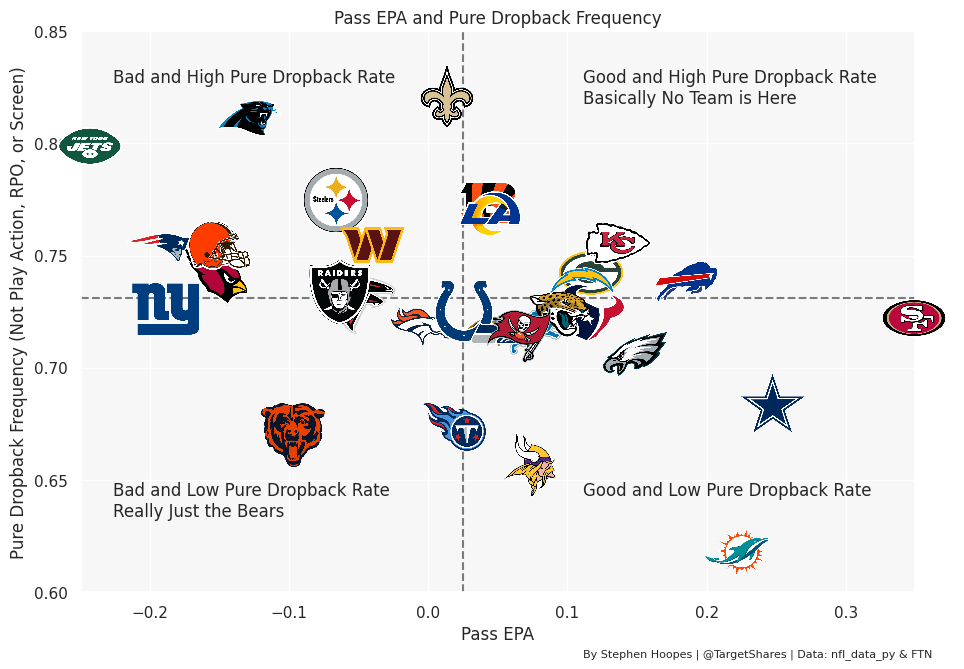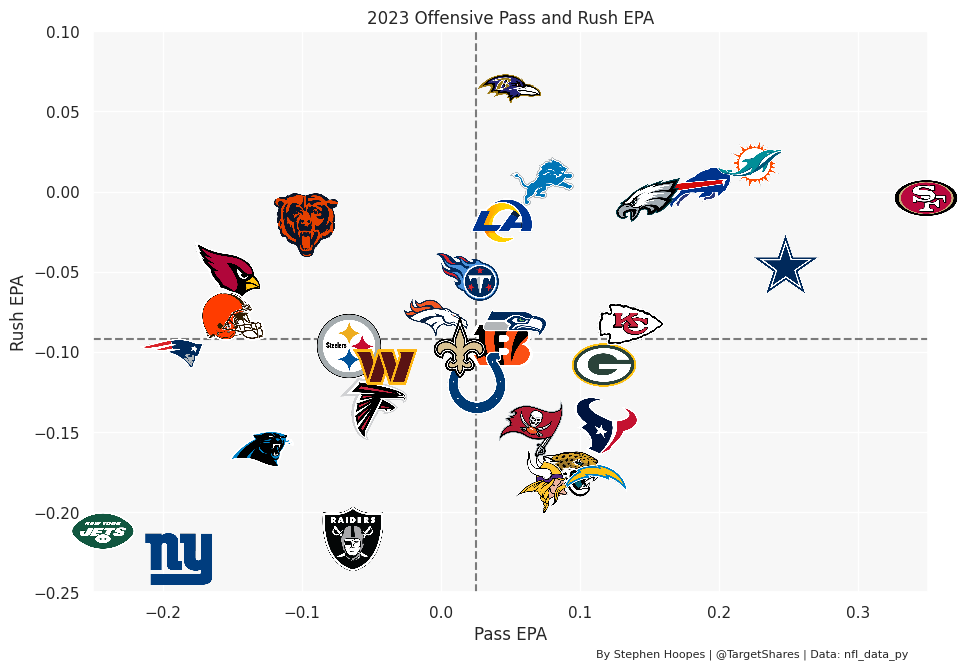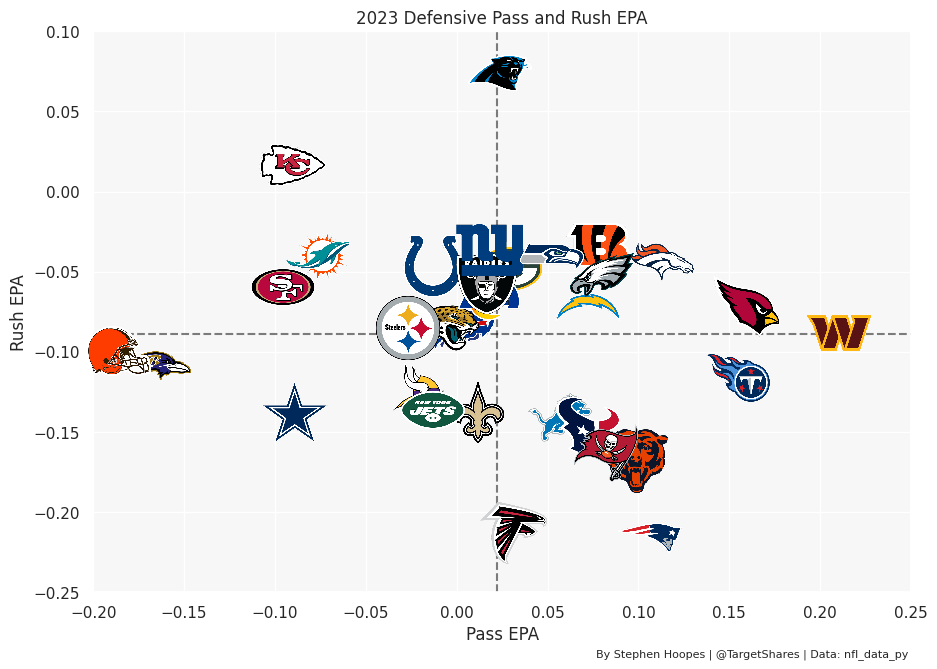The Top 10 Things You Need to Know About Week 14 for Fantasy Football (2023)
If you’re reading this in early December, you’re likely to have some fantasy teams either locked in to the playoffs or about to face pivotal Week 14 matchups. I wanted to start today with an acknowledgement of how difficult fantasy football is before talking about creative offensive play calling and WRs getting volume in new situations. Let’s get into it!
Searching for the Next Edge
Fantasy football is an incredibly challenging game. To win, you’re looking to maximize the number of players on your roster with game-winning upside. Players like Tyreek Hill that can score so many points that they single-handedly spike your win probability. The real edge is finding these players before they are a consensus top-24 flex option. In my home league (shoutout to PAM), I got incredibly lucky earlier this season snagging Raheem Mostert. And then again nabbing Tank Dell before his primary breakout.
I bring up these players because I think they’re good illustrations of two larger points. The first is that team and player situations are constantly fluctuating. Raheem Mostert’s situation has been defined by the Dolphins’ massive offensive success but also De’Von Achane’s health. Tank Dell’s situation has been defined by the huge success of CJ Stroud but now Dell’s season-ending injury. Throughout the season, I relied heavily on both players for wins at different times. And I’ll now need to find the next iteration of these players as we enter the fantasy playoffs.
That leads me to my second point. How do we go about finding these players? I think we always need to start with talent, and two of my favorite resources are Next Gen Stats and ESPN Analytics. Mostert has consistently flashed in rushing yards over expected, while Dell is a top-10 receiver in open score. But we also need to consider both the overall offensive environment and coaching decisions (to the best of our ability). The latter can be particularly frustrating for running backs.
Two potential options for the stretch run are Zack Moss and Zay Flowers. Both are not consensus top-24 players rest of season, have flashed talent, and have had injuries on their teams that benefit their opportunity share. They’re not as cheap as Mostert or Dell were but with such little time remaining in the season, it’s tough to find inexpensive, game-winning upside. But in general, you’re going to need to stay ahead of your competition. If you can find a talented player whose situation has changed for the better and who doesn’t have insanely irrational coaching, be aggressive in getting them before their breakout.
Three Changing WR Situations
Speaking of changing situations, three little-discussed WRs had big days in new circumstances. The first is Elijah Moore. Joe Flacco took over at QB for the Browns and promptly peppered Moore with targets. It wasn’t a massive fantasy day, with Moore finishing with four receptions and 83 yards, but it could’ve been much bigger. Moore led the entire league in air yards with 244 in Week 13. Now a lot of these were “prayer” yards but it’s undoubtably a positive indicator for Moore moving forward with the Browns passing 4.3% over expectation and Flacco willing to throw the ball down the field.
Jonathan Mingo similarly has seen a lot more volume with the coaching staff changes in Carolina. He finished Week 13 with 10 targets, six receptions, and 69 receiving yards. He led the Panthers with a 38.5% target share and a 32.4% team air yards share; both elite numbers. There are two primary problems with Mingo rest-of-season. The first is the terrible state of the Panthers offense. They’ve been unable or unwilling (perhaps both) to push the ball down the field, with Bryce Young landing in the bottom-four in air yards per attempt. Additionally, Mingo frankly hasn’t been that good so far to start his career. Among 128 qualifying receivers, he’s 122nd in ESPN Analytics’ open score.
The final receiver is DeVante Parker. With Bailey Zappe at the helm, Parker earned a 37.5% target share and a massive 52.2% team air yards share. But despite the nine targets, Parker ended the day with just four receptions and 64 receiving yards. There are a lot of similarities to Mingo’s situation. The Patriots offense has been abysmal all year. Parker hasn’t been very good this season, actually ranking behind Mingo at 125th in ESPN Analytics’ open score. And Parker has an additional concern, which is Demario Douglas was missing from their Week 13 matchup.
If I was going to chase the Week 13 performance of any of these players, it would be Elijah Moore, who has the talent to take advantage of the changing scenario.
Offensive Efficiency and Creativity
The first graph below shows passing efficiency on the x-axis and pure dropback frequency on the y-axis. SumerSports defines this as the percentage of pass attempts that don’t include play action, a run-pass option (RPO), or a screen. So, think of these as traditional QB dropbacks. What you’ll notice is there are very few teams either in the top-right or bottom-left of the graph.
The bottom-left quadrant has teams that are inefficient passing but use a large amount of play action, RPOs, or screens. It’s really just the Bears that are any reasonable distance from the boundaries. And I talked how the Bears’ insanely high use of screens wasn’t really fooling anyone last week. In the top-right, there really isn’t any team with any reasonable distance from the boundary.
So, what does this mean? To me, there is a pretty clear correlation between offensive success and the use of non-traditional dropbacks. Teams like the Dolphins and Cowboys have a very low pure dropback rate and have elite passing efficiency marks. Meanwhile, the Panthers and Jets are among the top-three teams in pure dropback rate and are both in the bottom-six in passing efficiency.
Love our content? Check out the GoingFor2 Live Podcast Network!
Now, I’m not arguing this is the only reason. But I would think teams with struggling QBs would rely more on pass attempts that require less things to go right. By that I mean less pass blocking and easier QB decision making. In addition to player talent, I like to look at how creative and effective a team’s offensive play calling is before determining stretch run fantasy targets. Try your best to avoid teams in the top-left quadrant.
One final point on RPOs is connected to the second graph below. The x-axis is the share of a team’s plays coming from RPOs and the y-axis is the combined target share of a team’s top 2 receivers. Ben Gretch noted a connection between the two a few months back and we still do see a loose connection throughout 2023. Different sites have substantial differences in RPO numbers and RPOs are obviously a small percentage of total plays and so can’t be solely explanatory, but the connection does still seem to persist. So, in general, the top pass catchers on teams utilizing a lot of RPOs will earn larger target shares than offenses without RPO usage.


Broncos and Eagles: Interesting 3rd Down Notes
Both the Broncos and Eagles lost in Week 13 but they diverged substantially on 3rd down performance. The Broncos finished the day without converting a single first down on 11 3rd down attempts. That makes winning a football game incredibly difficult and they did well to keep it close with the Texans. Denver passed the ball 8.2% below expectation against a Texans defense that has been a top-5 rushing defense but below average stopping the pass. The Broncos have been run-heavy all season and have the second-lowest variance in their play calling tendencies. So, while it wasn’t a surprise, it still doesn’t make the decision-making any better.
Meanwhile, the Eagles’ performance on 3rd down was one of the only reasons the game was somewhat close versus the 49ers. They managed to convert on 3rd down with 5+ yards to go seven times. Ultimately, the Eagles averaged -0.11 EPA/play on 1st and 2nd downs but +0.73 on 3rd and 4th downs. Shoutout to the 49ers defense that has been elite in stopping the pass this season, falling behind only the Browns and Ravens. Combine that with easily leading the league in offensive passing efficiency and the 49ers are going to be difficult to beat in 2023.


Chargers: Lack of Rushing Success
I’m worried about Austin Ekeler. The Chargers lost 9.8 expected points on 21 designed runs in Week 13. They ended the game with only 29 yards on 24 carries including QB scrambles. The Chargers are now in the bottom-six of rushing efficiency on the season. And the advanced stats don’t look great for Ekeler, either. He now has a slightly negative rushing yards over expected per attempt mark. And he’s in the bottom-12 among qualified rushers in Next Gen Stats’ success rate. I do think the volume will still be there and his matchups aren’t terrible the rest of the way. But given he’ll be 29 years old when the season starts next year, I’m wondering if the bottom has fallen out for Ekeler’s fantasy career.
Interception Model
The interception model had a great week. Focusing on the sample where the model had the greatest confidence (+/- 5% from 50% odds), it correctly predicted whether a QB would throw an interception 78% of the time. It was one of the most profitable weeks for the model, and it was correct on both the players I called out in last week’s article (Trevor Lawrence and Kenny Pickett unfortunately both got hurt in the process). This week, the model likes both Patrick Mahomes (57%) and Joe Flacco (56%) to throw an interception. And it likes both Gardner Minshew (38%) and Jordan Love (42%) to avoid throw picks. Have a great week everyone!
ATTN Dynasty Commissioners: Do you want to do something cool for your league? How about a 1-hour live show dedicated to YOUR league? Team-by-team breakdowns, rankings, and more. For details and to book a show, visit: GoingFor2.com/plp.






